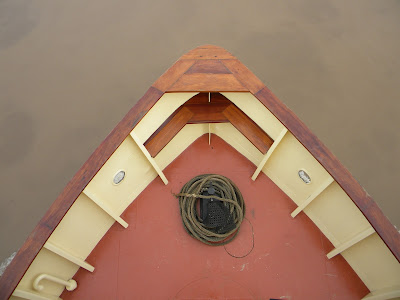I was late learning that there had been a fatal fire in 2016 aboard the boat I had cruised on and blogged about in 2014. The Wall Street Journal was reporting about the case and contacted me in March 2017 about using a photo of the boat that appeared on my blog. (In the blog post, I enthusiastically recommended both the boat and its operator, International Expeditions, which Jane and I have used for two trips in South America.)
Since then, I've read more about the incident, which was truly horrible: the deaths themselves, a lack of safety equipment and training on the boat, the theft of wedding rings from the bodies, and what seems to be the tone-deaf response of International Expeditions. It seems that a working smoke detector in the cabin could have awakened the couple and alerted the crew. Like most fatal fires, it didn't have to happen, and the fact that boats and ships are not held to same standards as other common carriers made things even worse for the victims' family.
 |
| The prow of La Estrella Amazonica. We were on the boat for a week and found it very comfortable, the food good and the staff professional and friendly. It was shocking to learn about the fire. |
I contacted International Expeditions to ask what safety changes have been made since the fire. I've read that the company has "enhanced" safety equipment and improved training. I don't think it's a good sign that the company didn't respond to my query.
In public relations, which I used to teach at Salisbury University in Maryland, it's recommended that a company take several steps to recover from this sort of disaster. It's called crisis management or damage control. The way Tylenol recovered from several poisoning deaths in 1982 is considered the textbook response: be totally forthcoming about what happened; act immediately to ensure no one will be harmed in the immediate future; compensate victims or their families; make known what long-term actions you're taking to make it almost impossible for something like this to happen again. Has IE taken these steps?
One cosmetic change I could see on the IE website. The boat, formerly La Estrella Amazonica, is now simply the Amazon Star. Changing the name of a boat is thought by some people to invite bad luck. In this case, the bad luck already happened, and the name is merely in a different language, but it might make it less likely that curious prospective clients will learn of the boat's past.
My 2014 posting about cruising aboard La Estrella Amzonica can be seen HERE.
The Wall Street Journal's April 6, 2017, about a fatal fire aboard La Estrella Amazonica and the victims' daughters' search for answers can be seen HERE.
People magazine also reported on the fire and the victims' family; click HERE.
I've never thought much about personal safety when travelling other than avoiding getting mugged, often not drinking the water, and sometimes taking out travel insurance that includes medical evacuation. What happened to Christy and Larry Hammer aboard La Estrella Amazonica should be a lesson in watching out for oneself. I didn't check that there were smoke detectors when I was on that boat two years earlier. I didn't look for fire extinguishers or ask why we didn't have a fire drill.
Nor did I ask whether any of the crew had medical training, though it became clear that no one did when a passenger seriously injured himself while on a shore excursion (he went back to the skiff for something and fell) and was awkwardly and painfully taken back to the boat and eventually taken away on a float plane. Fortunately, there was an American nurse among the passengers who did what she could to stabilize him and minimize his pain.
No one would expect a physician on a boat of this size, but given the isolation of the region where the boat operates, the crew should include someone with emergency medical training. And there should be smoke detectors.

No comments:
Post a Comment